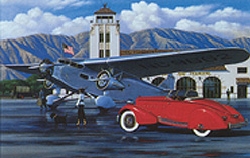|
|
| 1934 American Classics |
|
 |

|
 |
|
|
| DESCRIPTION |
 |
| 16 x 11.5 Inch Collector Size Unframed Lithograph $40.00
Stan Stokes in his painting 1934 American Classics created exclusively for The Stokes Collection beautifully portrays a Hollywood movie star and her pet dog embarking on a chartered Ford Trimotor from the Grand Central Air Terminal (owned and operated by Curtis-Wright) in California. Probably bound for a weekend visit to San Simeon the palatial retreat of the publishing magnate William Randolph Hearst the trip to San Luis Obispo will take only ninety minutes. The early afternoon rains have left puddles on the tarmac but fair skies have returned to the San Gabriel mountains and the trip should be a smooth one. During the Great Depression the Packard Company introduced some of its most stunning and high performance automobiles. The 1934 Packard LeBaron Speedster pictured in the painting was one such machine. Costing nearly $8000 the Packard LeBaron Speedster was about two to three times the price of a nice three bedroom house. Only the very wealthy could afford such luxuries during the Depression. Note that the Speedster's fenders are reminiscent of the wheel covers on racing planes during the era of the Thompson Trophy Air Races. The Speedster was powered by a 160 HP V-12 engine which displaced 445 cubic inches. Around this time it is believed that among the Hollywood notables that owned Packard Speedsters were both Clark Gable and Douglas Fairbanks. The Ford Trimotor was introduced in 1926 and between 1926 and 1933 Ford produced approximately 200 of these capable aircraft. Ford Trimotors remained in service long after they were made technically obsolete by more modern aircraft and it is reputed that one aircraft built in 1928 was still in regular service as late as 1970. Admiral Byrd utilized a 4-AT version of the Trimotor for his 1929 Antarctic expedition. The Ford Trimotor played an important role in introducing commercial aviation to the general public during the years of the Great Depression. The basic model carried eleven passengers and a crew of two had a cruising speed of 107 MPH an operational ceiling of 16500 feet and a range of 570 miles. Due to its corrugated metal exterior skin the Trimotor was affectionately known as the "Tin Goose." The Tin Goose had a wingspan of nearly 78 feet and was fifty feet in length. In 1930 Transcontinental and Western Air (TWA) began the first coast-to-coast commercial service utilizing Ford Trimotors. The trip took "only" thirty-six hours if the weather was cooperative. |
|


|